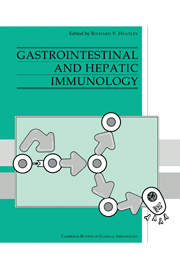Book contents
- Frontmatter
- Contents
- List of contributors
- Preface
- 1 Lymphoid cells and tissues of the gastrointestinal tract
- 2 Lymphocyte migration to the gut mucosa
- 3 Regulating factors affecting gut mucosal defence
- 4 Gastritis
- 5 The immunology of coeliac disease
- 6 Inflammatory bowel disease
- 7 Food intolerance and allergy
- 8 Gastrointestinal and liver involvement in primary immunodeficiency
- 9 Secondary immunodeficiency – the acquired immunodeficiency syndrome (AIDS)
- 10 Intestinal infections
- 11 Lymphomas
- 12 Small bowel transplantation
- 13 Clinical aspects of immunologically mediated intestinal diseases
- 14 Chronic active hepatitis
- 15 Primary biliary cirrhosis
- 16 Immunology and immunopathology of acute viral hepatitis
- 17 Immunology of liver transplantation
- 18 Clinical correlates with hepatic diseases
- Index
3 - Regulating factors affecting gut mucosal defence
Published online by Cambridge University Press: 03 February 2010
- Frontmatter
- Contents
- List of contributors
- Preface
- 1 Lymphoid cells and tissues of the gastrointestinal tract
- 2 Lymphocyte migration to the gut mucosa
- 3 Regulating factors affecting gut mucosal defence
- 4 Gastritis
- 5 The immunology of coeliac disease
- 6 Inflammatory bowel disease
- 7 Food intolerance and allergy
- 8 Gastrointestinal and liver involvement in primary immunodeficiency
- 9 Secondary immunodeficiency – the acquired immunodeficiency syndrome (AIDS)
- 10 Intestinal infections
- 11 Lymphomas
- 12 Small bowel transplantation
- 13 Clinical aspects of immunologically mediated intestinal diseases
- 14 Chronic active hepatitis
- 15 Primary biliary cirrhosis
- 16 Immunology and immunopathology of acute viral hepatitis
- 17 Immunology of liver transplantation
- 18 Clinical correlates with hepatic diseases
- Index
Summary
Introduction
The traditional view of functionally independent compartmentalised biological systems has, during the last decade, largely been surpassed by an awareness of the co-operation of diverse cell types to achieve a common goal. This new theme of lsquo;interactive systems’ is exemplified by a consideration of the intestinal nervous and immune systems. A large body of data has been amassed showing that messenger molecules are shared by these two systems and are active in both systems. Indeed, it is more realistic to consider the nervous and immune systems as extreme ends of the neuroendocrine-immune continuum.
With the exception of lesions in the skin, antigen gains access to the body by oral intake or inhalation and the significance of this becomes apparent when we consider that the human mucosal surface area equals ∼400 m2 as compared to ∼2 m2 of skin. In light of this constant antigenic insult, it should come as no surprise that with 1010 plasma cells/m2, the intestine is the largest lymphoid tissue in the body (Beagley & Elson, 1992). This gut-associated lymphoid tissue (GALT) can be divided into three compartments: aggregates in follicles and Peyer's patches; diffuse elements of the lymphoid and reticuloendothelial network; intraepithelial lymphocytes. When antigen enters the intestinal submucosa/mucosa a variety of immune (of lymphoid and myeloid origin) and non-immune (epithelial, stromal) cells interact to remove the noxious stimulus and thus maintain a constant interstitial environment. When this homeostatic mechanism is compromised, or inappropriately exaggerated, pathophysiological reactions can occur and disease may develop (Fig. 3.1).
- Type
- Chapter
- Information
- Gastrointestinal and Hepatic Immunology , pp. 48 - 75Publisher: Cambridge University PressPrint publication year: 1994



